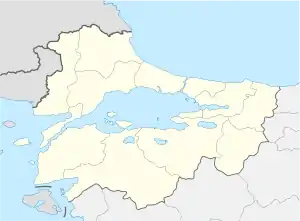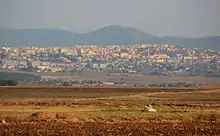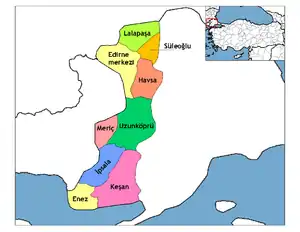Keşan
Keşan is the name of a district of Edirne Province, Turkey, and also the name of the largest in the district town of Keşan (Bulgarian: Кешан; Greek: Κεσσάνη, Byzantine Greek: Ρουσιον, Rusion)[3][4][5][6] In 2010 Keşan had a permanent population of 54,314; in the summer this increases to 70,000 because of an influx of tourists. The mayor is Mehmet Özcan (CHP).
Keşan | |
|---|---|
 Keşan  Keşan  Keşan | |
| Coordinates: 40°51′00″N 26°38′00″E | |
| Country | |
| Province | Edirne |
| Government | |
| • Mayor | Mehmet Özcan (CHP) |
| • Kaymakam | Metin Borazan |
| Area | |
| • District | 1,187.36 km2 (458.44 sq mi) |
| Population (2012)[2] | |
| • Urban | 57,478 |
| • District | 79,716 |
| • District density | 67/km2 (170/sq mi) |
| Website | www.kesan.bel.tr |
Keşan district is bordered by İpsala and Uzunköprü to the north, Malkara to the east, Şarköy to the southeast, Gelibolu and the Aegean Sea to the south and Enez to the west.
Agriculture and commerce are the two most important sources of income in Keşan. Because of its proximity to Greece, there is a daily flow of tourists in and out of the district.
Literacy is 98%.
The local music includes gaida, tupan, and hora dance.
History

Humans have lived here continuously from the 30th century BC. The first inhabitants were the Proto-Thracian and Thracian tribes. A lot of Thracian coins of the Odrises have been found here.[7] From 580 BC to 1359 AD first it was a central part of the Odrysian kingdom of Thrace, and after that was ruled by the Persian Empire, the Macedonian Empire, the Roman Empire (including i.е. Byzantine Empire), the Bulgarian Empire, the Byzantine Empire, the Latin Empire, again the Bulgarian Empire and the Byzantine Empire.[8][9] The Thracian town on Via Egnatia mentioned by Klaudios Ptolemaios and by many others[10] during over of 1900 years before the Turks, have the names: Zorlanis (and Zerlanis, Zorlanae, Zorlanea), Topiris (and Topir, Topiro, Topirion), Kission (and Kissos, Kissan, Kissupolis), Rusion (and Russa, Roussa, Rossion)[3][4][5][11][12] in Greek ρουζ - rous mean rouge. Here is the place of the remarkable Battle of Rusion where the Bulgarian Tzar Kaloian defeated the Latin empire army in 1206,[13] and again spread the Bulgarian control over the fortress that begin form the first Bulgarian conquest in 538 AD and the nexts: of khan Zabergan in 559, Bulgarian and Slavs in 617, 623 and 626, Caesar Tervel in 705 and 717-718, Great khan Krum in 813, Tzar Simeon the Great in 896, 913, 921, 922 and 923, Bulgarian troops in 1047, Tzar Ivan Asen II in 1235-1236, Tzar Michail Shishman in 1328. The castle of Rusion was stay on the hill about 4 km southwest of center of the present Kesan and some ruins still exist around 40.826272N 26.679587E at so called "Kaletepe" (tur.- Fortress hill).[4][14]
Rusion fallen not easy under Osman Turks - first In 1359 fortress was taken for a short time by ınvaders of Gazi Süleyman Paşa and finally - in 1362 by Lala Şahin Paşa.[5][11] In the Ottoman Empire Rusion renamed as Rusköy (tur. Rus village)[3][12] the name derived from the medieval fortress-town,[4] and later - to Keşan (from gr. Kissos, Kissupolis)[15] belonged to the Galipoli Sanjak, and as such part of the Rumelia Eyalet and then the Province of the Kapudan Pasha. It was a nahiya center in Enez kaza at first, later was bounded to İpsala kaza. It was transferred to the Eyalet of Edirne in 1530. According to the Ottoman population statistics of 1914, the kaza of Keşan had a total population of 30,644, consisting of 15.371 Greeks, 15.221 Muslims, 51 Armenians and 1 Jew.[16]
Keşan was invaded by the Russians in 1829 and in 1878, by the Bulgarians between 1912 and 1913 (on 14 November 1912 Bulgarian Hayrabol detachment commanded by colonel Petar Salabashev[17] take the town[18] and Tzar Ferdinand reside some days here[5]), by the Greeks between 30 of July 1920 and 1922. It was ceded to Republic of Turkey on 19 November 1922. Keşan district reached its present borders after the separation of nahiya of Enez in 1953. A huge part of the population are the Bulgarian speaking Muslims, the relocatians from Bulgaria and Greece, gipsies,and Turkmens.[7]
Notable people
- Selim Sesler (1957–2014), clarinet virtuoso of Romani heritage
- Aleko Trendafilov - volunteer in Thesaloniki detachment of the Bulgarian Macedonian-Adrianopolitan Volunteer Corps, born and resident of Keşan[19]
- Kosta Yanev - volunteer in 3rd company of the 10th Prilep battalion of Bulgarian Macedonian-Adrianopolitan Volunteer Corps, born and resident of Keşan[20]
References
- "Area of regions (including lakes), km²". Regional Statistics Database. Turkish Statistical Institute. 2002. Retrieved 2013-03-05.
- "Population of province/district centers and towns/villages by districts - 2012". Address Based Population Registration System (ABPRS) Database. Turkish Statistical Institute. Retrieved 2013-02-27.
- Kenneth M. Setton, Norman P. Zacour, Harry W. Hazard, A History of the Crusades: The Impact of the Crusades on the Near East Wisconsin University Press 1985, p. 545
- Hakan T. Karateke, Evliyā Çelebī’s Journey from Bursa to the Dardanelles and Edirne, From the Fifth Book of the Seyāḥatnāme, Leiden - Boston 2013, p. 197
- Hakan Eşme, Keşan'ın Tarihçesi
- История на българите под редакцията на Димитър Зафиров, C 2007, p.151
- Keşan - Rumeli Balkan Edirne haberleri, Trakya-net.com/
- Simeonova, Liliana V., Keşan (Russian) Ortaçağda Via Egnetia’da önemli bir kale, Keşan Sempozyumu (2003 : Keşan). - Keşan, 2006, s.: 252-255
- Andreas Külzer, Tabula Imperii Byzantini. vol. 12 (TIB12) Ostthrakien (Eurōpē), Austrian Academy of Sciences Press, Vienna 2008, p. 620-622
- Miller, Tabula Peutingeriana -
- Mete ESİN. Keşan Bahânesiyle-1, 20.04.2006
- Mete ESİN. Keşan Bahânesiyle-2, 20.04.2006
- "Проф. дин Николай Овчаров, Цар Калоян отбива Марица заради битка". Archived from the original on 2017-12-01. Retrieved 2017-12-03.
- Rusion on Wikimapia
- Walter E. Kaegi, Jr., Byzantinische forschungen, Amsterdam 2011, p. 187
- Kemal Karpat (1985), Ottoman Population, 1830-1914, Demographic and Social Characteristics, The University of Wisconsin Press, p. 170-171
- Симеон Радев, Това, което видях от Балканската война, C 1993
- Красимир узунов, Генча Начев, Забравената война, 2013
- „Македоно-одринското опълчение 1912-1913 г. Личен състав“, Главно управление на архивите, 2006, стр. 730.
- „Македоно-одринското опълчение 1912-1913 г. Личен състав“, Главно управление на архивите, 2006, стр. 818.
